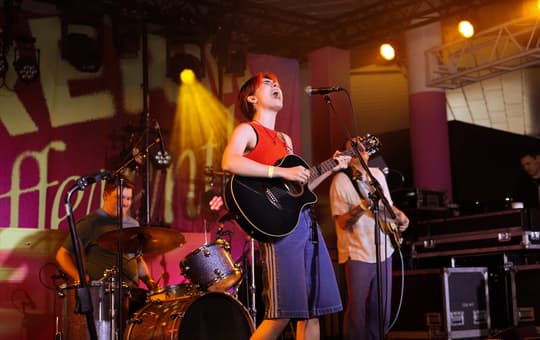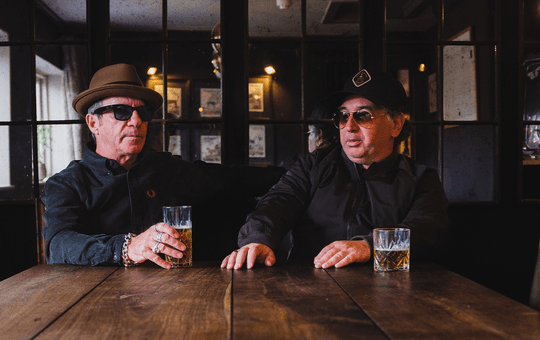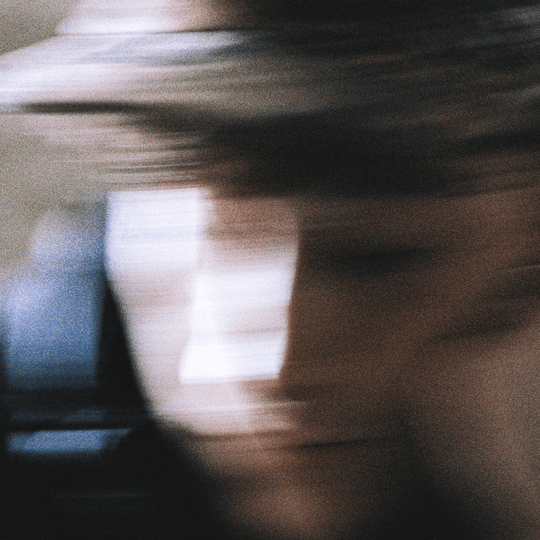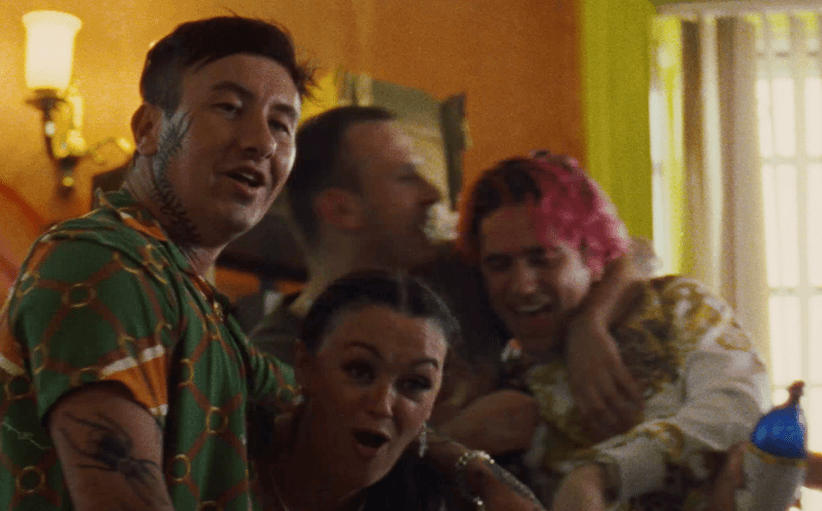The Dummy Guide to The Fall
THE FALL are live. They are live like the electricity that crackles through your walls: a burst of energy that thrusts forth from the stage or fills your speakers with noise. And like all live things their pulse is constant yet they are rarely still, they are changing, evolving; the story of The Fall is full of many sounds, yet the repetitive throb of drums and noise is ingrained; full of many musicians but Mark E. Smith, their bile spitting poetic core, is constant; in the words of John Peel The Fall remain “always different, yet always the same”. They are Live. It is the ugliness, the poetry, the blood and guts. It is Life.
They are live, live like Gil Scot Heron’s revolution will be: working musicians, street wise and full of the ‘now’, getting the job done by growing from the past and adapting to overcome. Over 34 years they have engaged with styles as diverse as techno and rockabilly, and Mark E. Smith has dispatched and hired band members with Darwinian ruthlessness. From charity shop Mancunian postpunkers, bringing Krautrock to industrial estates on their 1979 debut album ‘Live at the Witch Trials’, they were incarnated in the 1980s as besuited near pop stars with charting singles from critically acclaimed albums, through a brief dalliance with the avant garde via their 1988 collaborative ballet ‘I Am Kurious Oranj’, to the heavier garage sounds of the last decade.
But was there ever a band more intimidating than the Fall? Intimidating – not just because of their pummeling sound and Smith’s caustically poetic lyrics – but also from a simple logistic point of view. Their 34 years of intense productivity, 33 studio albums and 50-plus lineups make the prospect of diving into their output bloody terrifying. A multitude of intimidating music performed by ever-changing group of ‘backing’ musicians all fronted by Mark E. Smith, otherwise known as ‘the most intimidating man in music’? Fear not, here is the Dummy’s map as a guide to the wonderful and frightening world of the Fall.
Repetition, Repetition, Repetition
Primarily, The Fall pummel. Their intensity bursts from stage and record with an immediacy that terrifies and inspires. At the heart of this immediacy is their dedication to Mark E Smith’s ‘three R’s’: Repetition, Repetition, Repetition. This desire for repetition in the music is set out on their first release, the 1978 EP ‘Bingo-Master Break-Out’ and most explicitly on its B side, taken up entirely by the unfussy 5 minute long clarion call ‘Repetition’. From it’s opening line ‘Right, Noise’ (dutifully supplied with a screeching guitar line) down to its unforgiving beat onslaught we are presented with the sounds that remain most consistent throughout The Fall’s eclectic output, no fanciness here, here be stark repetition.
Post punk
At the beginning of their career The Fall were heavily associated with the Manchester post punk scene. The Buzzcocks’ label New Hormones had funded ‘Bingo-Master Break Out’ and, while the band were not signed by Tony Wilson’s Factory Records, they had featured on his Granada music show. Their first album ‘Live at the Witch Trials’ (1979) has all the youthful surge and swarming noise of the Mancunian post punk scene mixed with the Krautrock repetition that of their first EP.
The sound develops
With their second album ‘Dragnet’ (1979) The Fall’s sound began to take shape, the throbbing beat at the heart accompanied by Steve Hanley’s driving bass lines (which Smith himself conceded was The Fall’s ‘signature sound’) and louder and clearer in the mix were Smith’s musings and rants. But it is over their next three studio albums ‘Grotesque (After the Gramme)’ (1980), ‘Hex Education Hour’ and ‘Room To Live’ (both 1982), as the production values, the band’s dynamic and Smith’s lyrics improve, that this ‘post punk meets krautrock in an estate pub with a drunken landlord poet’ sound sharpens to a point, and songs such as ‘Totally Wired’, ‘Hip Priest’ and ‘Hard Life in Country’ hit home like spears.
Mark E Smith, poet of industry
Through what Smith describes as a ‘north Mancunian’ filter, his lyrics probe popular culture with sharpness and surreality to expose the throbbing, grinding, repeating life beneath. His anger and energy are focused through his mumbled acerbic lyrics shedding light alternatively on the facades and innards of a multitude of topics as diverse as football culture, politics, notions of success, art, rejection, love and war. Despite his deadly cynicism and bile Smith’s lyrics are, above all, in awe of, and fascinated with playing with, language, this playfulness begins most acutely to hit the fore at the start of their next ‘stage’, kicked off in 1983 with the arrival of Mark’s first wife, the American born Brix Smith.
(READ DOM FROM MOUNT KIMBIE’S FAVOURITE LYRCS HERE)
Brix and the popular rise of The Fall
‘Perverted by Language’, released in 1983, was the first album to feature Brix. Despite taking lead vocals on one track her most evident presence in the band is the perceptible movement the album makes towards a more accessible sound. The pulse remains but it is clear from songs such as ‘Garden’ and ‘Eat Y’Self Fitter’ that the band are happy to move away from the punk sound and attitude that pumped through the veins of their previous releases.
The new found clarity of The Fall’s output during this phase of their existence led to the surprising appearance of them on the nation’s radio and television (in part thanks to the massive support of uberfan John Peel) including an appearance on Top of the Pops, with Smith dressed not in his charity shop uniform of earlier days but in a rather dapper suit! They had charting singles such as ‘Mr Pharmicist’ on ‘Bend Sinister’ (1986) and ‘Victoria’ and ‘Hit the North’ on ‘The Frenz Experiment’ (1988) whilst they produced the challenging yet pop leaning albums ‘The Wonderful and Frightening World of The Fall’ (1984) and ‘This Nation’s Saving Grace’ (1985).
Art, surreality and ballet
In the midst of this mainstream attention Mark E. Smith began to address more directly his arthouse inclinations and his ever- present sense of the surreal. The band’s 1988 album ‘I am Kurious Oranj’, was born out of collaboration between Smith and the avant-garde ballet group led by Michael Clark. The album broke their run of critically and popularly acclaimed albums but showed that once again The Fall were not afraid to dwell in a place ignored by the most ardent of musical travellers. The performances, complete with giant hamburgers and the band performing behind fantastically costumed dancers were astonishingly odd, though the album, sadly, never quite touched those heights.
Brix leaves, chaos returns
In 1989 Brix and Mark divorced and she left The Fall and in the releases that followed the dalliances with the mainstream and the arthouse seemed over. The Fall’s first guitarist Martin Bramah returned (predictably only for a couple of albums) and so too did the chaos and the unrelenting darkness. This time round the jagged edge of their 1970’s sound remained absent, replaced with a cold almost post-apocalyptic sheen, a future darkness that shrouds albums such as ‘Extricate’ (1990) and ‘Code:Selfish’ (1992). Their sound minimises further and the essentials of repetition resound more strongly than in their 1980s output, in some cases, most notably 1998’s ‘Levitate’ they incorporate the mechanical beats of the IDM movement growing in the UK at the time. The pop elements introduced during Brix’s tenure are not entirely absent in these releases and Smith’s linguistic playfulness is always apparent but the sound of a darker future pervades.
The End Days?
In 1998, in the midst of a tour of the States, a fight breaks out on stage at Brownies club in New York, The Fall finally, very publicly, erupt into the violence that had always flowed beneath their sound. Smith, goading his band mates by flicking lit cigarettes at them was at the heart of and bore the brunt of the aggression. Afterwards he is arrested for assaulting his band mate and then girlfriend Julia Nagle, he spends two nights in jail, the band leave him there and return to the UK. For the first time since the start of their career Steve Hanley, who provided the band’s all-important bass, quits. He does not return.
In 1999 Smith, with a new lineup (still with Nagle), releases ‘The Marshall Suite’, it is widely hailed as The Fall’s ‘comeback album’. Driven to the edge once again The Fall jump straight off and land fully formed on the other side, the album is a rambleshack mix of heavier garage band sounds and minimalist and more experimental pieces.
Re-Re-Re-birth
Despite how close they have got over the years The Fall have never died, so they will never be reborn. Since 2000 they have released a series of superb albums, the cream in this writer’s mind being the glacially produced and synthesizer heavy ‘The Unutterable’ (2000) and the almost sweet rollicking rock of ‘Fall Heads Roll’ (2005). Most importantly, it is 2010, The Fall are touring and they have released a new album, ‘Your Future Our Clutter’. The history is over, The Fall are present, their world is still there for the exploring, and that is all you really need to know.
The Fall are performing at FIELD DAY on the 31st July in Victoria Park, London.













